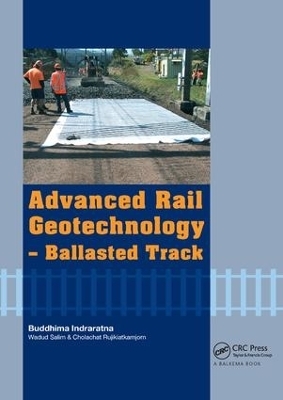
Advanced Rail Geotechnology - Ballasted Track
CRC Press (Verlag)
978-1-138-07289-3 (ISBN)
In Advanced Rail Geotechnology: Ballasted Track, the authors present detailed information on the strength, deformation and degradation, and aspects of fresh and recycled ballast under monotonic, cyclic, and impact loading using innovative geotechnical testing devices. The book presents a new stress-strain constitutive model for ballast incorporating particle breakage and validates mathematical formulations and numerical models using experimental evidence and field trials. The text also elucidates the effectiveness of various commercially available geosynthetics for enhancing track drainage and stability. It presents revised ballast gradations for modern high-speed trains capturing particle breakage and describes the use of geosynthetics in track design. It also provides insight into track design, capturing particle degradation, fouling, and drainage.
This book is ideal for final year civil engineering students and postgraduates and is a solid reference for practicing railway engineers and researchers with the task of modernizing existing track designs for heavier and faster trains.
Professor Buddhima Indraratna is a Civil Engineering graduate from Imperial College London, UK and holds a Masters degree in Soil Mechanics from the same Institution. He obtained his PhD from the University of Alberta, Canada in 1982. After working in industry and academia for several years he joined the University of Wollongong, Australia in 1991, where he is now Professor of Civil (Geotechnical) Engineering, and the Head of School of Civil, Mining and Environmental Engineering. Professor Indraratna has earned the reputation as one of the world’s leading researchers in rail geotechnology. His work is elucidated in many scholarly journals and invited keynote papers in numerous international conferences since mid-1990’s. His contributions through research and development towards the understanding of ballast and subgrade soil behaviour have been incorporated by numerous rail organisations into their engineering practices for the design and maintenance of ballasted tracks. The outcomes through strategic real-life projects and extensive laboratory testing over the past decade have lead to a major revision of current New South Wales standards for the placement densities of ballast on track and its size gradations, leading to significant track enhancement allowing greater axle loads at much higher speeds. Among numerous national and international awards over the past decade for his research contributions, Professor Indraratna was awarded the prestigious 2009 Business-Higher Education Round Table (BHERT) award by the Australian Government for his outstanding contributions to rail track innovations in collaboration with industry. In September 2014 Professor Indranata was awarded the C. S. Desai Excellence Medal by the International Association of Computer Methods and Advances in Geomechanics (IACMAG).
Introduction. Track Structure and Rail Load. Factors Governing Ballast Behaviour. State-of-the-art Laboratory Testing and Degradation Assessment of Ballast. Behaviour of Ballast with and without Geosynthetics and Energy Absorbing Mats. Existing Track Deformation Models. A Constitutive Model for Ballast. Track Drainage and Use of Geotextiles. Role of Subballast, its Drainage and Filtration Characteristics. Field Instrumentation for Track Performance Verification. DEM Modelling of Ballast Densification and Breakage. FEM Modelling of Tracks and Applications to Case Studies. Non-destructive Testing and Track Condition Assessment. Track Maintenance. Recommended Ballast Gradations. Bio-Engineering for Track Stabilisation. Appendices. Subject Index.
| Erscheinungsdatum | 14.07.2018 |
|---|---|
| Verlagsort | London |
| Sprache | englisch |
| Maße | 174 x 246 mm |
| Gewicht | 453 g |
| Themenwelt | Technik ► Bauwesen |
| Technik ► Fahrzeugbau / Schiffbau | |
| Technik ► Maschinenbau | |
| Technik ► Umwelttechnik / Biotechnologie | |
| ISBN-10 | 1-138-07289-3 / 1138072893 |
| ISBN-13 | 978-1-138-07289-3 / 9781138072893 |
| Zustand | Neuware |
| Informationen gemäß Produktsicherheitsverordnung (GPSR) | |
| Haben Sie eine Frage zum Produkt? |
aus dem Bereich


